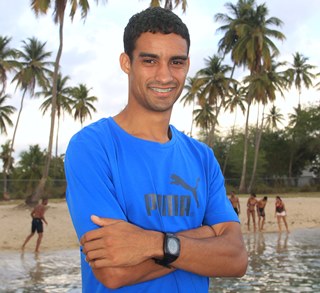media_artricles :: 2014
Born ready
Part 6: No challenge too great for Santos
Kwame Laurence :: Trinidad Express :: 09.05.2014Whatever the challenge, Luguelin Santos is up for it.
“I was born ready,” declares the 20-year-old quartermiler, during an interview with a group of international journalists.
There is a language barrier, and Santos speaks through an interpreter. His broad smile and infectious laugh, however, need no translation. This is a man excited about life and eager to conquer the world.
Santos faced adversity from birth, a rupture on his head requiring three stitches. This goes a long way in explaining his constant readiness for battle.
In 2012, at the London Olympics, Santos was just 18, but the Dominican Republic athlete fought like a man to earn silver in the men’s 400 metres final.
Some 20 months later, he is 20 and representing Interamerican University at Justas—the intercollegiate meet in Puerto Rico. You would think an Olympic medallist would be very careful about the extent of his participation. Not Santos. His green hair signals to all he is passionate about his school.
“I was to have yellow hair,” says a laughing Santos, “but for some reason it became green.”
The Interamerican uniform is yellow, green and white, so it works out well in the end.
Of even greater significance than the colour of his hair is Santos’s busy schedule on the final day of Justas, competing in the men’s 400m, 200m 4x100m and 4x400m.
Remember, Santos was born ready, and so, is undaunted by what seems an intimidating task.
As expected, he outclasses the opposition in his pet event, the 400m, completing his lap of the track in 45.36 seconds for a huge 65-hundredths of a second cushion on the runner-up.
Santos was just 18 when he seized silver in the Olympic 400m final in London, England. He clocked 44.46 seconds to finish behind Grenada’s Kirani James and ahead of Trinidad and Tobago’s Lalonde Gordon—an impressive Caribbean sweep of the medals.
Santos did not enjoy the same success three years earlier at the Hasely Crawford Stadium here in T&T. Representing Dominican Republic for the first time, he bowed out in the qualifying round of the Pan American Junior Championship men’s 400m event. His 47.88 seconds clocking earned him fifth spot in heat one.
“I was really impacted by one thing,” says Santos, with a spirited laugh. “I was in lane five, Rondell Bartholomew of Grenada in lane four. I was giving all I had at the 200-metre mark, and here comes this guy who runs past me in such a relaxed manner. He looks at me and moves away. I never forgot that.”
But there was nothing to be ashamed of. Santos was just 15 at the time, and was beaten to the line by 19-year-old Bartholomew and three 18-year-olds.
Just one year earlier, Santos started training in Santo Domingo with Jose Ludwig Rubio, the man who would go on to coach him to 2010 Youth Olympic Games gold, 2011 Pan Am Games silver, the world junior title in 2012, Olympic silver the same year, and bronze at the 2013 IAAF World Championships.
“At first sight he didn’t impress me,” says Rubio, through an interpreter, “but when I really started working with him as a coach day after day, I realised I was in for something special. Way back then I had about 60 athletes, and this kid was only 14, but he was very confident, very defiant—defiant to the point that he would really push the experienced guys in training. He showed a lot of capacity to endure the training.
“Then we moved into pre-competition training,” Rubio continues. “He ran a 500-metre test with another athlete, Orlando Frias, 1:05.13. It confirmed he was something special. Then I started to give him differential treatment.”
Rubio’s group is much smaller now—about 20—and the training base has moved from Dominican Republic to Puerto Rico.
The coach has built a tight unit, and the athletes are like family. In fact, both Santos and Honduran sprinter Rolando Palacios live with Rubio and his pregnant wife, Mariely Sanchez, a sprinter who represented Dominican Republic at the 2008 and 2012 Olympics.
When it’s time for training, Rubio’s charges are serious and focused. But they sure know how to have fun, an afternoon at the beach producing tonnes of laughter as well as fierce rivalry in an impromptu run/swim/run relay.
Santos is a competitor to his heart, and though no Olympic medals are on offer, he gives a big effort.
Rubio has undoubtedly discovered a rare gem and, more importantly, has found the formula to make it shine.
“I have a lot of confidence in myself,” says Santos, “but I have to admit I’m really surprised by my own rapid progress. I felt I could achieve big things in the sport, but I never thought I would achieve it so quickly. When I ran 44.71 in the (2011) Pan Am Games in Mexico, I said ‘oh my God, this is a dream’.”
Just 17, Santos had broken the 45-second barrier. It comes as no surprise he’s now taking on the sub-44 challenge. “Yes, it’s a goal I would love to achieve this year. It would be great to be part of that exclusive club, 43 seconds. But you know what? If I don’t achieve it this year, automatically it will become a goal for the following year.”
Santos’s main rivals on the circuit are Olympic champion James and the 2013 World Championship gold medallist LaShawn Merritt, of the United States.
When the three quartermilers squared off at the Drake Relays in Iowa, USA, last month, Merritt emerged victorious, beating James and Santos into second and third, respectively. But Santos got revenge at last Saturday’s Jamaica International Invitational. He got home first, forcing Merritt to settle for silver.
All things being equal, Santos will have many more battles with Merritt and James. But there’s another quartermiler on the horizon who Rubio believes has the potential to challenge the Big Three. His name is Juander Santos. He’s the 17-year-old brother of Luguelin, and is also part of Rubio’s training group in Puerto Rico.
“I see more potential in Juander, compared to Luguelin back in 2008 when I first met him. He’s taller, he’s got a stronger build. I see him as an unpolished jewel. Our aim is Rio 2016, but don’t be surprised if you see quicker progress.
“For Luguelin, Felix Sanchez was his role model. For Juander, it’s actually his own brother. Juander’s got spikes. His brother didn’t have that. He’s got good-quality training gear that he inherits from his brother courtesy his sponsor, so he’s got a better lifestyle (than Luguelin had), which I believe will help him succeed.”
Typically, the elder Santos is not worried about the potential threat of young Juander.
“No matter what, I will beat him,” is Luguelin’s declaration, accompanied by his trademark hearty laugh.
The response is good-natured, but it tells the story of a man ready for the challenge—ready for any challenge.
kwame.laurence@trinidadexpress.com
EDITOR’S NOTE: Express writer Kwame Laurence is among a select group of sports journalists chosen to be part of the latest IAAF Day in the Life series, a project featuring some of the Caribbean’s best athletes as well as other major players in the sport of track and field. Next Friday, a new chapter.

Enlarge Image
RELAX MODE: Luguelin Santos on the beach in Puerto Rico while his teammates, in the background, have some fun. Photo: JEAN-PIERRE DURAND for the IAAF

Close Window